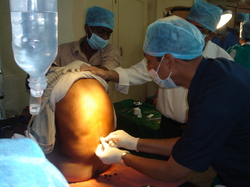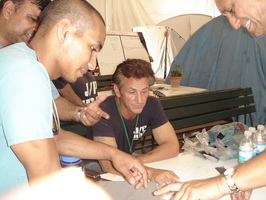Nitin Shah's son, daughter-in-law and two grandchildren know the drill. He won't be joining them this Christmas.
And they couldn't be prouder.
While they certainly would enjoy spending the holiday with him, the reason behind his usual late-December absence truly embodies the spirit of the season, and the essence of this man: He will be in India saving and improving countless lives.
 Dr. Shah flies from his home in Southern California to his homeland on Dec. 23. He's made this journey almost annually since 1999, organizing and participating in events that bring basic and specialized medical care to those who drastically need it. The upcoming visit is longer than usual, and it offers promise of impacting many more lives, all of which he will explain below.
Dr. Shah flies from his home in Southern California to his homeland on Dec. 23. He's made this journey almost annually since 1999, organizing and participating in events that bring basic and specialized medical care to those who drastically need it. The upcoming visit is longer than usual, and it offers promise of impacting many more lives, all of which he will explain below.
But, first, there's an obvious question to be answered: Why?
Why does he do it? Why does he carve so much precious time from his family and his busy career as a professor of anesthesiology and critical care at Loma Linda University Medical Center, and as the chief of surgical ICU and assistant chief of anesthesiology at the VA Long Beach Healthcare System?
He prefaces his answer by paraphrasing a Chinese proverb about happiness.
If you want to be happy for an hour, go take a nap.
If you want to be happy for a day, go golfing.
If you want to be happy for a month, get married.
If you want to be happy for a year, inherit a fortune.
But if you want to be happy for a lifetime, go help someone else.
"We are all obligated to help family, friends and acquaintances," he said. "But when you go out of the box and help somebody else, the joy that you get is just limitless. When I told this to my daughter-in-law a few years back, she said, 'Yeah, Dad, it makes you feel good, but it doesn't last.' I said, 'That's why you must do it every day.'
"Actions may not bring happiness, but there is no happiness without an action," he continued. "Health is the best wealth we can ever have. That is why I do what I do."
During this trip to India, Dr. Shah will be taking part in the launch of a program called Saving Children's Lives: India. My organization, the American Heart Association, is involved in this because of our commitment to saving and improving lives. We have the science and training to make a difference, so it's our obligation -- and our honor -- to help. In fact, we've successfully launched similar programs in Botswana and Tanzania.
It is my pleasure to have Dr. Shah continue this conversation about the important work he and his peers are doing, throughout the year and throughout the world.
---
I've always believed that charity begins at home, and Southern California is my home. This is why over the past 23 years, I have organized and run close to 150 health fests, including one in Anaheim that has grown into a three-day medical surgical camp that will help so many thousands of people that it must now be held at the Anaheim Convention Center.
I also can never forget India, the place of my birth, my upbringing and my education. This is how my international adventures in health fests began. I have since done about 43 missions abroad, primarily in India, but also in Zambia, Malawi, South Africa, Fiji, Haiti (following the 2010 earthquake) and Jamaica.
Here is how these work: If someone has a connection in the medical field in a particular country, and that matches a specific need among the people, I gather a group of people who can address those specific issues. A wonderful example was my most recent trip, which was to Jamaica in September.
A philanthropist from Tampa, Florida, told me about a hospital where people sorely needed cataract procedures. I arranged for a team that also included an ophthalmologist from India whose wife is a dermatologist, allowing for another area of care. In five days, we did 225 cataract surgeries and treated 107 dermatology cases. That was the factory we set up.
 My favorite example comes from a 2007 surgical mission to Kalidas Hospital in Vyara, India. We did 145 hernia and hydrocele operations in only three days! This has become an annual three-day event and we have done more than 1,300 such operations total so far. This was such a staggering figure that in 2012 it was recorded in the "Limca Book of Records," which is considered India's Guinness Book of World Records.
My favorite example comes from a 2007 surgical mission to Kalidas Hospital in Vyara, India. We did 145 hernia and hydrocele operations in only three days! This has become an annual three-day event and we have done more than 1,300 such operations total so far. This was such a staggering figure that in 2012 it was recorded in the "Limca Book of Records," which is considered India's Guinness Book of World Records.
I started my journey of medical missions abroad by attending a medical/surgical camp at Bidada Hospital in Bidada, India in 1999. Bidada is a small village with a population of 2,500 people. They've organized annual mega camps every January since 1974. They see about 20,000 to 25,000 people and perform around 1,000 operations in 20 days.
All of these experiences are known among my peers at the American Association of Physicians of Indian Origin (AAPI), the largest ethnic organization of physicians. I'm proud to say that I was appointed Chairman of Medical Missions and Community Service Committee last year.
This year, AAPI and the American Heart Association are collaborating on Saving Children's Lives: India.
Research shows that 6.3 million children around the world die every year before their 5th birthday -- and a frightening 20 percent of those deaths (1.26 million) occur in India. The most horrifying part is that many of the deaths are from causes we consider preventable -- things like diarrhea, infections and fevers.
The answer lies in quick, correct treatment. Knowledge and tools must be established, and then awareness made among those in the area.
On this initial trip, our goal is to lay the foundation. We want to meet the local workers, assess their level of competence and figure out if they have a good model in place. So rather than going in to treat patients, our focus this time is training the trainers, teaching them what to do when someone calls or visits with diarrhea, fever or possible pneumonia. Our objective is long-term; we want to build something sustainable.
While my trips to India always fall near Christmas, the truth is we do this because that is when the weather is best. November through February is the most optimal time. Having lost my wife in 1991, and not remarrying for nearly 20 years, I felt comfortable with my decision to build this trip into my annual calendar. Someone has to do it; why not me?
I've never regretted it. Any misgivings about being away from my family and my business flee as soon as I see a 2-year-old who'd come in with a cracked lip and a cracked palate who looks good now, or the old person who gets to see again after 10 years. That is my reward.
My passion for treating others -- the desire that lured me into medicine to begin with -- still fuels my soul. This is why I'm so excited about launching Saving Children's Lives: India.
This trip is only the first baby step. But the potential is tremendous. So is the need. Hopefully we can make a difference.
To reach Dr. Shah, email him at nitinshahmd@gmail.com. Learn more about Saving Children's Lives:India and about the crowdfunding campaign to support this program.

